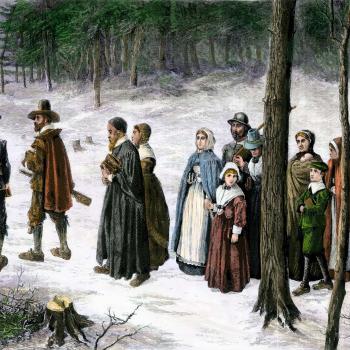When you have a lot of different terms floating around, it’s easy for things to get mixed up. So let me be clear about something: evangelicalism, fundamentalism, Christian Patriarchy/Quiverfull, and the homeschool movement are not synonymous. In an attempt to avoid confusion, I’m going to take a moment to define each and to explain how they relate to each other.
In brief, evangelicalism and fundamentalism are both religious movements that share some commonalities but also have distinctions – evangelicals are more likely to be engaged in the world while fundamentalists are more likely to embrace separation from the world, for example. Homeschooling is a diverse movement which can be broken into two general groups: those Christians who homeschool for fundamentalist religious reasons, and those from a variety of backgrounds who homeschool for other reasons. Christian Patriarchy/Quiverfull is made up of a loosely connected group of organizations that promote extremely strict gender differences, submission to the family patriarch, and raising up armies of children for Christ. These organizations have gained a great deal of influence in the Christian segment of the homeschool movement, and evangelicals and fundamentalists who homeschool encounter Christian Patriarchy/Quiverfull, sometimes unwittingly, through homeschool literature, conferences, and leaders. This is how Christian Patriarchy/Quiverfull gains its new recruits.
Evangelicalism:
Evangelicals are a diverse bunch: some are liberal, some are conservative, and some are somewhere in between. Regardless of their differences, they share four characteristics:
1. Conversionism – “An emphsis on the ‘new birth’ as a life-changing experience of God”
2. Biblicism – “A reliance on the Bible as ultimate religious authority”
3. Activisim – “A concern for sharing the faith”
4. Crucicentrism – “A focus on Christ’s redeeming work on the cross”
Evangelicals have historically been very willing to change with culture, maintaining these four characteristics. They are fast to embrace new technologies like radio, direct mail, and television for their ministries and try to be culturally relevant to attract as many followers as possible. Evangelicals commonly attend megachurches, with thousands of attendees, and this phenomenon is growing. These churches feature contemporary worship music and classes on every topic and for every age group you might imagine. They function like huge community centers.
Evangelicals have embraced female equality, maintaining only an occasional mention of a husband’s role as his wife’s spiritual head. Evangelical women work, and evangelical children go to youth group, generally live normal teenage lives, and usually go to public schools. Evangelicals’ Jesus-talk and Bible-talk differentiate them from others, as does their insistence on others’ need for conversion and salvation, but otherwise, their lives are pretty, well, normal. Evangelicals don’t try to isolate themselves from the world, as their goal is simply to convert the world through their witness.
Sources: David Bebbington and Mark Noll
Fundamentalism:
Fundamentalists can also be diverse, though they are less so than are evangelicals. They are identified by four main characteristics:
1. Evangelism
2. Biblical Innerancy
3. Premillenialism
4. Separatism
In some sense, fundamentalists share all of evangelicals’ beliefs, but place a special emphasis on Biblical inerrancy, premillenialism, and separation from the world. Evangelicals may take the Bible as the foundation of their beliefs, but is fundamentalists who see it as literal and completely inerrant. Fundamentalists don’t see any of the Bible as cultural, and are not comfortable with higher criticism of the Bible. Because of their premillenialism, fundamentalists also are more pessimistic; while many evangelicals are also premillenialists, fundamentalists place a greater emphasis on this doctrine.
But what really separates fundamentalists from their evangelical cousins, even more so than their insistence on Biblical literalism and awaiting the second coming, is their emphasis on separation from the world. Fundamentalists see the world as an evil place, and seek to withdraw from it rather than to engage in it. Fundamentalists avoid contact with the world, seeking to remain pure. They wear long skirts, eschew dancing or rock music, and sometimes even wear head coverings. Many of them put their children in Christian schools or homeschool them, trying to shelter them from the world and keep them from evil influences. While your evangelical is going to blend in, your fundamentalist will not.
Because of their insistence on the literal truth of the Bible and their identification of feminism with the depravity of the modern world, fundamentalists are more traditional than evangelicals in their ideas about the woman’s role. Many forbid women from working outside of the home or speaking in church, though this varies slightly from group to group. Fundamentalists are also likely to attend small independent churches, some of which place a good deal of importance on the authority of the pastor.
That said, the line between evangelicals and fundamentalists can be a bit gray. After all, plenty of evangelicals believe in Biblical inerrancy and are premillenialists, and some fundamentalists place less emphasis on separation from the world than do others. While the difference between these two can be highlighted by the contrast between the evangelical megachurch, with its contemporary music and modern dress code, and the small independent fundamentalist church, with its traditional service and insistence on long skirts and sometimes even head coverings, it is worth pointing out that there are plenty who fall between these two extremes.
Source: Nancy Ammerman, Betty DeBerg, Margaret Bendroth
Christian Patriarchy/Quiverfull:
Christian Patriarchy teaches that God institutes a divine hierarchical family order. It holds that a woman must always be under the authority/headship of a man, whether that is her father, her husband, or, if widowed, her son. In addition, Christian Patriarchy teaches that the woman’s place is in the home while the man’s place is the public sphere: men are to provide and protect and women are to care for the home and the children. Quiverfull teaches that families must have large numbers of children, sometimes eschewing birth control altogether, to raise up “soldiers for Christ.”
While fundamentalists believe in strict gender roles, and evangelicals admit that men and women are different, Christian Patriarchy goes further. Christian Patriarchy insists that a hierarchical patriarchal family is the divine order and is essentially God’s institution on earth. The church is minimalized and the family is elevated. Each family member has his (0r her) role to play, and must obey those in authority over him (or her) even as he (or she) would obey God. Quiverfull also introduces teachings that are not at all part of evangelicalism or fundamentalism, which generally seek to convert others for Christ rather than speaking of birthing armies for Christ.
Where do these ideas come from? The short answer is, I don’t know. The more I think about it, I think that there is some influence of Calvinism and the reformed tradition at work here. The reformed tradition has long emphasized the patriarchal family and has long embraced the importance of hierarchy. Some of the main Christian Patriarchy/Quiverfull organizations, such as Vision Forum, are strongly Calvinist, and many who embrace Christian Patriarchy/Quiverfull are reformed. Yet at the same time, some organizations who promote Christian Patriarchy/Quiverfull, such as the Institute for Basic Life Principles and No Greater Joy, are not Calvinists, and there are plenty of evangelical and fundamentalist families who have adopted these views, or at least some aspects of them.
Regardless of where these ideas originated, there came to be a collection of organizations and leaders promoting Christian Patriarchy/Quiverfull. Some churches have come under the sway of these organizations and ideas, but the main way they have promoted their ideas is through the homeschooling movement. After all, homeschooling is actually a key tenet of Christian Patriarchy/Quiverfull – the father is the head of the patriarchal family, and the children should not have outside influences that might erode that authority. These organizations, especially Vision Forum, the Institute for Basic Life Principles, and No Greater Joy, therefore turned to producing literature, materials, and programs for homeschooled students.
Source: Kathryn Joyce
The Homeschool Movement:
The homeschool movement was begun in the 1970s by left-wing alternative school promoters, but was taken over in the 1980s by fundamentalists fleeing the perceived evils of the public school system. While the homeschool movement has always been diverse, scholars have found it useful to break the movement into two groups: Christian homeschoolers who see the public schools as evil and want to shelter their children and bring them up on “God’s truth,” and homeschoolers who may or may not be Christian but homeschool for other reasons, such as to provide an individualized curriculum, because the schools in their area are crappy, or to work around a gymnastics or ballet schedule. These two groups have not gotten along well together, and there has been tension and conflict in the homeschool world from the local to the national.
I call these two groups of homeschoolers the “believers” and the “inclusives” (borrowing Milton Gaither’s terminology). Because they homeschool in order to shelter their children from evil influences, believers generally only join homeschool groups with statements of faith that exclude those who are not believers. Inclusives, on the other hand, generally form and attend groups that are inclusive of all homeschoolers, and do not discriminate based on belief. In a sense, there is the homeschool movement writ large, with its diversity of individuals and reasons for homeschooling, and then within it is a subset which I call “the Christian homeschool movement,” made up of the believers, those Christians who are homeschooling in order to shelter their children and instill their religious beliefs in them. Outside of the Christian homeschool movement are the other homeschoolers, the inclusives, and these two groups of homeschoolers have their own distinct homeschool leaders, conventions, and literature.
When families enter the homeschool movement, they generally gravitate toward either the believers or the inclusives. While it might seem like families should split simply based on their initial reason for homeschooling, this isn’t always the case. Some parents who start homeschooling for non-religious reasons but have conservative religious beliefs gravitate toward the believers. Then, over time, their reasons for homeschooling change until they, too, are homeschooling to shelter their children from the evils of the public schools. This is actually a fairly common story. On the other hand, liberal and moderate Christians, along with others who start homeschooling for non-religious reasons, generally gravitate toward the inclusives.
When new homeschoolers gravitate toward the believers, attending their conventions, their co-ops, and sometimes even their churches (yes, there are churches that are predominantly made up of homeschoolers), they come in contact with Christian Patriarchy/Quiverfull. The literature, the speakers, the teachings – many well-meaning parents are sucked in, and before they know it, they’re teaching their daughters that they are to be homemakers, having their seventh or eighth baby, and deciding that their children will find mates through parent-guided courtships. Whether they identify themselves as evangelicals or as fundamentalists, or even as reformed, these parents have, unwittingly or not, embraced Christian Patriarchy/Quiverfull.
This is not to say that every believer or every Christian homeschool group embraces Christian Patriarchy/Quiverfull. Plenty of believers reject the beliefs of Christian Patriarchy/Quiverfull even as they continue to homeschool for religious reasons, and plenty of Christian homeschool groups have nothing to do with Christian Patriarchy/Quiverfull. Sometimes Christian homeschool groups even split over these issues. Furthermore, in some homeschool communities there is middle ground and even cooperation between the believers and the inclusives, and lines are less clearly drawn. Regardless, the believers, who seek to shelter their kids and escape from evil influences, are naturally susceptible to Christian Patriarchy/Quiverfull, which offers the promise of the perfect godly family, and Christian homeschool groups can serve as ideal breeding grounds for these ideas. Within the Christian homeschool movement, the influence of Christian Patriarchy/Quiverfull is strong. Some families influenced by Christian Patriarchy/Quiverfull adopt it wholesale while others take bits and pieces and leave the rest.
While it might seem that fundamentalists, who already endorse strict gender roles, would be attracted to Christian Patriarchy/Quiverfull while evangelicals would not, this is in practice not completely true. Yes, Christian Patriarchy/Quiverfull is especially attractive to fundamentalists, but if evangelical parents gravitate toward believers and come in contact with the literature and leaders of Christian Patriarchy/Quiverfull, they may find their beliefs changing. My parents were one of these families. They were evangelicals, and originally believed that women could have careers outside the home, that daughters become independent at 18, and that male headship is largely symbolic. But the contact they had with Christian Patriarchy/Quiverfull after they started homeschooling changed their views, slowly but surely, until they had embraced Christian Patriarchy/Quiverfull nearly wholesale.
Note: Essentially every scholar who has studied the homeschool movement has found it useful to break homeschoolers into the same two groups, though their labels vary: believers and inclusives, ideologues and pedagogues, or closed-communion and open-communion. It should be remembered, though, that this does employ some degree of simplification. For example, there are also Catholics who homeschool for religious reasons and are generally not very accepted in the Christian homeschool movement, where the believers frequently write Protestantism into their statements of faith. These Catholics sometimes form their own Catholic homeschool groups, organizations, and publications. There are also a growing number of Muslims who homeschool for religious reasons. Naturally enough, these non-Protestants who homeschool for religious reasons, including Catholics, Muslims, and others, generally find themselves welcome in inclusive homeschool groups and shut out of the believers’ homeschool groups. This once again reveals the ways in which the believer/inclusive divide can be useful in understanding the homeschool movement.
Source: Jane Van Galen, Mitchell Stevens, Milton Gaither
Conclusion:
Evangelicals and fundamentalists, along with their reformed cousins, generally come in contact with the Christian Patriarchy/Quiverfull movement in the Christian homeschool movement, which has been its incubator for the last several decades. Some reject these new beliefs, but others adopt them wholesale and enter the world of Christian Patriarchy/Quiverfull.
It is important to remember that while Christian Patriarchy/Quiverfull has a great deal of influence in the Christian homeschool movement, there are those in the Christian homeschool movement who reject these teachings, and, in addition, the believers who make up the Christian homeschool movement do not speak for all homeschoolers. There are also the inclusives who make up the remainder of the homeschool movement, which generally has different publications, different homeschool groups, and different curriculum. Not all homeschoolers endorse Christian Patriarchy/Quiverfull. In fact, the vast majority don’t.
It is also important to remember that most evangelicals and fundamentalists do not embrace the teachings of Christian Patriarchy/Quiverfull. Except for those who get pulled into Christian Patriarchy/Quiverfull, which happens almost exclusively through the homeschool movement, evangelicals soundly reject the tenets of Christian Patriarchy/Quiverfull, and fundamentalists also reject a good number of them. The vast, vast majority of evangelicals and fundamentalists have nothing whatsoever to do with Christian Patriarchy/Quiverfull, which is at the moment a very small movement populated by a mixture of evangelical, fundamentalist, and reformed families who reside within the Christian homeschool movement.
I say all this because I discuss a number of different issues on this blog and don’t want to confuse my readers. As an atheist, I disagree with both evangelicals and fundamentalists, and I think many of the things that they teach are harmful, but when I discuss Christian Patriarchy/Quiverfull I am speaking of a movement that is essentially a subculture of the homeschool movement, not something widespread at all among evangelicals, or even among fundamentalists. While they overlap at certain points, you cannot make an equivocation between evangelicals, fundamentalists, Christian Patriarchy/Quiverfull, and the homeschool movement.
That said, the problems with Christian Patriarchy/Quiverfull that I discuss here are not unique to this movement. Plenty of those who grew up in the homeschool movement but not in Christian Patriarchy/Quiverfull were still overly sheltered and ended up feeling stifled. Plenty of those who grew up fundamentalists were discouraged from questioning religion or their religious leaders. Plenty of those who grew up evangelicals faced rejection from their families if they left those beliefs. The problems, emotions, and dilemmas I blog about, then, are not unique to Christian Patriarchy/Quiverfull.
Note: For another look at the influence of Christian Patriarchy/Quiverfull in the Christian homeschool movement, see Influencing the Christian Homeschool Movement to take them into Patriarchy and Dominion. I disagree strongly with this blogger theologically (he’s fundamentalist), but I agree with his concern about the growing influence of Christian Patriarchy/Quiverfull movement in the Christian segment of the homeschool movement.














